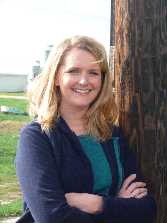
A growing number of U.S. pork producers are taking time out of their busy days to build connections with those who buy their products. These agricultural advocates, often called “agvocates,” will tell you that the time they spend speaking to groups, blogging and providing straightforward and factual information through social media outlets, such as Facebook, Twitter, YouTube and Pinterest, is an investment in the future of farming.
Risk Management Strategy
Justin Roelofs, AgStar Financial Services, Mankato, MN, considers agricultural advocacy to be an important part of pork producers’ risk management strategies. Roelofs says a long-term key to producer profitability could actually depend on a producer’s willingness to become more involved in advocating for agriculture.
“With such a small portion of the population involved in agriculture — even fewer in animal agriculture — advocacy will be vital in the long term,” he explains. “Some countries have not had advocacy programs in place to address animal rights groups’ agendas, which has led to much smaller industries and higher food costs. It is critical that everyone involved in agriculture help educate the general public, who may not understand modern agricultural practices. Providing this education is a vital risk management tool going forward.”
‘Tell Your Story’
Chris Chinn, and her husband, Kevin, are fifth-generation farmers near Clarence, MO. They operate a 1,500-sow, farrow-to-finish operation as part of a joint-farming venture with Kevin’s parents and brother as part of Chinn Hog Farm. They also raise cattle, hay and row crops.
Chinn says she started realizing the importance of telling agriculture’s story when she and her husband were part of the American Farm Bureau Federation’s Young Farmers and Ranchers Committee. “As we traveled through airports and were visiting with people, I started to realize people were disconnected from farming; fewer people understood much about agriculture.” She also realized that the negative perceptions about agriculture had the potential to impact her children’s chances of taking over the family farm or having a future in agriculture.
“Agriculture is under attack,” she explains. “I realized that, like it or not, farmers have targets on their backs. I realized I had better start telling my story.”
Chinn (at right) started blogging on the Farm Bureau Young Farmer’s and Rancher’s website in 2007. In 2010, she launched a personal blog under the heading,“My farm, my family, my story” (chrischinn.wordpress.com).
As she monitored comments to her blog, her confidence grew,and she then started reaching out to tell her story through Facebook and Twitter. One of her tweets about last summer’s drought was picked up by a CNN reporter, leading to both a story and a positive relationship that helped her reach a new and larger audience.
“Having the chance to work with the CNN reporter was an amazing opportunity,” she relates. “It opened my eyes to how one person could make a difference.”
CNN recently ran one of her blog posts about animal care and antibiotic use with the headline,“Why My Hogs are on a Healthcare Plan,” also available on the website nationalhogfarmer.com/health/hogs-don-t-have-health-insurance-myth-antibiotic-use-0.
Faces of Farming
Chris Chinn was recently chosen as one of four farmers to represent the U.S. Farmers and Ranchers Alliance (USFRA) in its “Faces of Farming” program. She will travel throughout the country, speaking to groups and conducting interviews with key media outlets.
The outreach efforts on behalf of the USFRA are a natural extension of the steps Chinn and others were already taking to get the real message out about how farmers take care of their land and animals.
“I have a YouTube video that allows people to see inside our hog barns. I also use Facebook, Twitter and my blog to connect with people outside of agriculture,” she explains. “My goal is to help more people engage in meaningful conversations about how food is produced, and why changes have taken place on the farm or ranch. I want people to see the values that farm and ranch families have, and understand our intentions are always to improve the quality of care we give to our animals and our land. I realize many people are skeptical about technology on the farm, and I hope the Faces of Farming program can help clear up the misinformation that has been mistaken as the truth.”
Chinn urges other pork producers to get involved with telling their stories, too. “I know what it’s like to be scared. It’s a scary thing to put yourself out there.” She suggests taking baby steps. “I started with my blog and moved to other social media outlets when I had built my confidence. I stumbled and learned as I went along. Do what you are comfortable with at first,” she adds.
Chinn has set a goal to spend 20 minutes a day advocating for agriculture. “Sometimes I spend that time writing my blog; other days I may concentrate more on Twitter or Facebook. Other days I take time to comment on articles that have been posted about agriculture on the Internet,” she explains.
Naturally, not everyone will agree. “Everyone has a right to their opinion. Sometimes, we have to politely agree to disagree. I want to take the time to clear up misunderstandings and make sure that I answer questions from people who really do want to learn more about agriculture,” she says.
She encourages all pork producers to tell their story — and speak from the heart. “I talk about what impact my farm could have on people’s lives. I relate how a change in hog prices or corn prices can make a difference when it comes to their food,” she adds.
You may also want to read:
"Game-Changing" New Products Featured during 2013 World Pork Expo New Product Tour
About the Author(s)
You May Also Like



